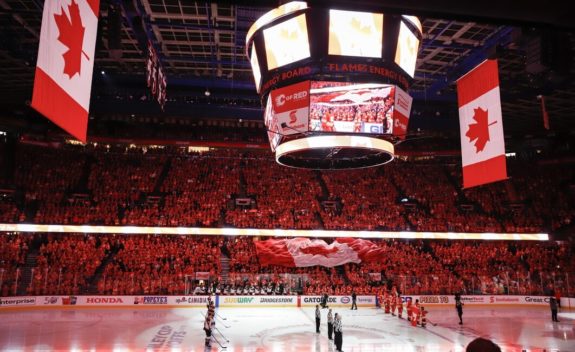The most important moment for the Calgary Flames franchise in decades won’t happen on the ice. After roughly 14 years of discussions, negotiations and near-misses, the Flames, the City of Calgary and Calgary Stampede jointly announced a tentative arena deal on Monday night at City Hall.

The only thing standing between a new arena being built in Calgary is ratification of the deal by city council in a vote held just days after they voted to eliminate $60 million from the local government budget.
A Brief History of Calgary’s Arena
Built in advance of the 1988 Winter Olympics, it’s safe to say that the Scotiabank Saddledome has seen better days. Designed with a striking saddle-shaped parabolic roof – the very thing that inspired its name – the ‘Dome has become a bit of a relic, with its distinctive roof also struggling to withstand the weight of the heavy rigging that many major concert performers use for their arena tours.
The Flames began exploring the possibility of a new arena in 2015. The scope of their plans shifted when they bought a controlling interest in the Canadian Football League’s Calgary Stampeders in 2012. Following a severe flood that put nearly a dozen rows of the Saddledome underwater in 2013, the Flames unveiled plans for a combined stadium and arena complex – dubbed CalgaryNEXT – in the summer of 2015 which were panned by city council for being too ambitious, expensive and dependent on public money.
2017’s Negotiation Breakdown
At the city’s suggestion, the Flames pivoted back towards Victoria Park and a simpler facility primary aimed towards hockey and concerts. Talks progressed throughout 2016 and 2017, but they hit a wall in the summer of 2017 due to differences in opinion between mayor Naheed Nenshi and Flames executive Ken King regarding public contributions towards the facility. The debate became a point of contention during a 2017 mayoral election won by Nenshi by a slim margin.
At the time of the impasse, the Flames offered to put up $275 million (as a down-payment in lieu of rent or property tax) with the city putting up $225 million The city countered with an offer of $185 million apiece from the Flames, the city, and a ticket tax. The Flames felt they were being asked to give too much, while the city felt the Flames were asking for too much.
On the day before they opened training camp, the Flames declared that they were no longer pursuing a new building in Calgary. While they didn’t address relocation – and never uttered the word publicly – they stated that they would “hold on as long as they could” in the market.
The Deal on the Table
The year after the election, newly-minted city councilor Jeff Davison (and other members of council) put together a committee to examine the viability of an arena, and the city’s potential contribution to make it happen. Work by the committee led to talks kicking back up again, and eventually turning into a deal in principle after four months of talks.
The agreed-upon deal has the city and the Flames each kicking in $275 million. But in lieu of rent, the Flames will contribute $75 million over 35 years to local sports charities – effectively a continuation of their current deal with the Saddledome Foundation – and the city will get 2% of all revenues generated over the first 35 years, an amount the city estimates to be worth $155 million. If the city’s revenue forecasts can be believed, the city’s contribution gets trimmed down over time.
A Palatable, If Imperfect, Deal
While locals are a bit hesitant at sinking public money into an arena, particularly given the local government budget and job cuts, it’s likely that the deal is ratified at Tuesday’s meeting for a few reasons:
- The deal would continue investment into the Rivers District, an area just east of downtown that the city is hoping can be transformed into a cultural and entertainment hotbed.
- Since the 2017 election, the city council has juggled contentious discussions regarding the expansion of the local light rail system, the 2026 Olympics and major challenges with their property tax system. The council has taken it in the teeth and, to be blunt, could use a win to avoid being perceived as dysfunctional.
- With Mayor Nenshi’s popularity waning, there’s a strong possibility that Calgary could see a new mayor in 2021. Making progress with an arena and other investments in the Rivers District could give several mayoral hopefuls on council something to hang their hats on as the next election approaches.
The proposed deal isn’t perfect. But for a fan base and a city that’s been hearing about the Flames needing a new building for over a decade, an imperfect deal may be better than no deal at all. It’s up to council to weigh the pros and cons, and decide if an imperfect deal is one they can live with.